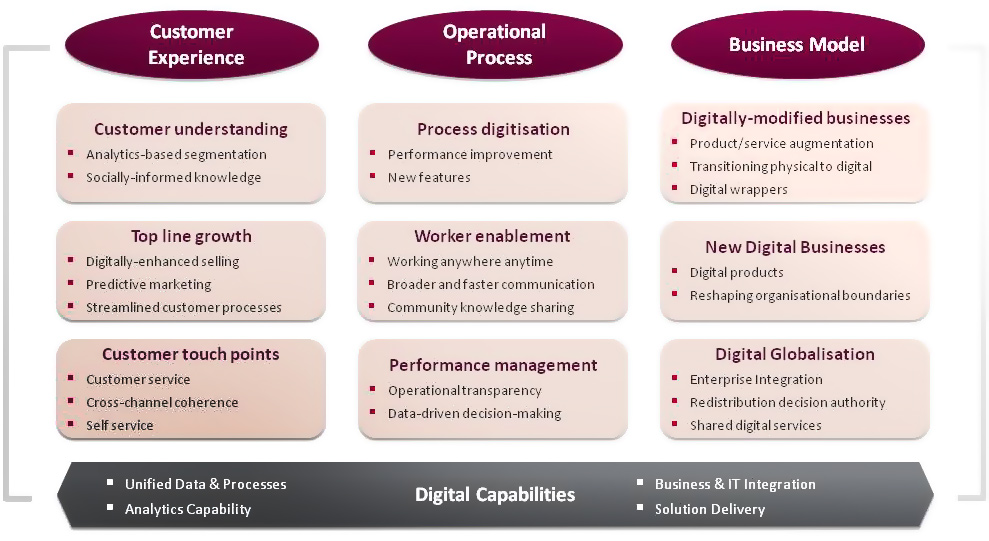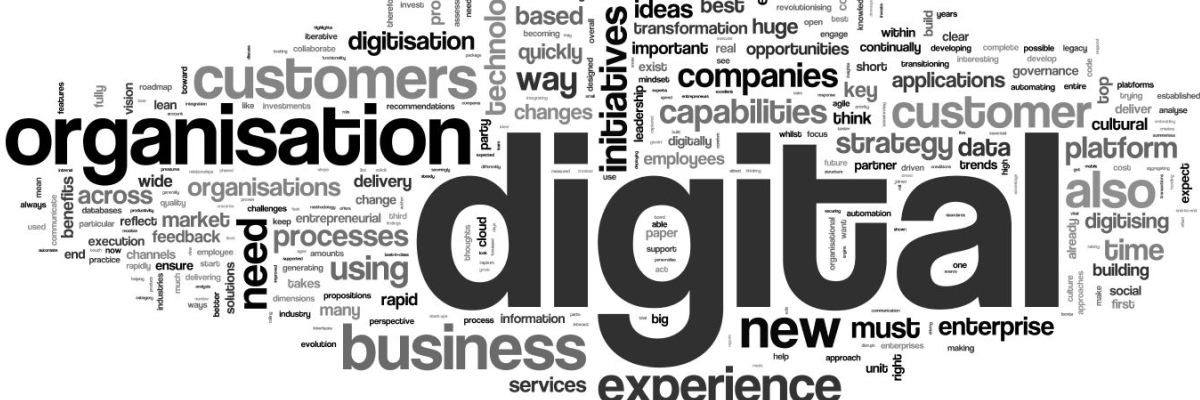Digital transformation refers to the changes associated with the application of digital technology in all aspects of human society.Digital transformation may be thought as the third stage of embracing digital technologies: digital competence → digital usage → digital transformation, with usage and transformative ability informing digital literacy. The transformation stage means that digital usages inherently enable new types of innovation and creativity in a particular domain, rather than simply enhance and support the traditional methods.
The use of technology to radically improve performance or reach of enterprises — is a hot topic for companies across the globe. Executives in all industries are using digital advances such as analytics, mobility, social media and smart embedded devices as well as improving their use of traditional technologies such as ERP to change customer relationships, internal processes and value propositions. Other executives, seeing how fast digital technology disrupted media industries in the past decade, know they need to pay attention to changes in their industries now.
Technology innovation is changing the game for businesses, industries, and markets. At the heart of this digital transformation is a host of new technologies that are disrupting the old ways of doing business – with partners, suppliers, and customers.
Digital transformation is the process of shifting your organisation from a legacy approach to new ways of working and thinking using digital, social, mobile and emerging technologies. It involves a change in leadership, different thinking, the encouragement of innovation and new business models, incorporating digitisation of assets and an increased use of technology to improve the experience of your organisation’s employees, customers, suppliers, partners and stakeholders.
Although the impact of digitization is not new, the digital economy is entering a new age that presents unprecedented challenges for all CEOs. Digital tools are invading the business environment, provoking significant changes in the way we work, communicate, and sell. This has given rise to new opportunities and challenges, and has triggered the Digital Transformation of enterprises. Capgemini Consulting has done research with MIT to define framework to support Digital Transformation.

(Source: Picture taken from Capgemini Consulting)
So, digital transformation hits each industry. But it can also affect all activities, divisions, functions and processes of the organization as it can impact the very business model as such. It’s important to remind that in a digital transformation (and, for that matter digital business) context, all these aspects, functions, processes, etc. are interconnected and silos have less (or no) place, not from a technological perspective but most of all also not from a process and people perspective.
Digital transformation projects requires several elements to succeed and digitization is a part of it. Among the many elements, we mention four that are related with technology, people and/or processes.
Change management.
As it is the case in virtually all impactful changes that affect multiple stakeholders, divisions, processes and technologies, there is not only an opportunity for change and looking at what can be done better and what should be (re)connected but also a need for change management.
Knowing the role of data and analytics in digital transformation, there are even more opportunities for change and needs for change management. This is not new: when web analytics became popular, for instance, their implementation and the connection between different data and analytics “silos” in the customer/marketing space, often showed clear needs for digital transformation in many customer-facing and customer-oriented operations, long before the term digital transformation became known. Grasp those opportunities and tackle the challenges.
Intent and priorities.
The world is full of roadmaps for virtually any digital transformation project. However, roadmaps are what they are and the intent, priorities, pain points and actual needs for the individual business and its ecosystem, within a broader reality, matters more.
There is never a one size fits all solution and intent, outcomes and priorities steer the digital transformation efforts, on top of changing parameters in the ecosystem. Priorities also means prioritization, often including looking at the low hanging fruit but always with the next steps and ultimate goals in mind, knowing these goals – and the context within which they were set – will evolve.
Digitization
We mentioned it before but it’s important. It’s a mistake to think that organizations are really ready for profound digital transformation in a broad way. There are still far too many gaps in regards to the digitization (and automation) of existing processes and the digitization of data from paper carriers. Worse: what is sometimes called digital transformation is sometimes “just” digitization (turning paper into electronic information into processes). You need digitization in order to optimize in a digital transformation context but digitization does not equal digital transformation. What matters is the combination, strategic and prioritized interconnecting and the actions you take to achieve business goals through digitization and combining data.
Furthermore, there is an even bigger gap between back-office processes and the front end. An example of this phenomenon can be seen in the financial industry, where there are extremely strong disconnects between the back-office and front end. There are lots and lots of digitization efforts that still need to be done in many areas of business and society and we all know and feel it, whether it’s in our daily experiences as “business people” or in the often totally unnecessary administrative tasks in regards to our government-related or finance-related ‘duties’ and interactions with business where we’re forced to use paper, the phone or channels we really don’t want to use anymore.
Silos, responsibility and skills
Digital transformation – just as social business, digital business and any form of customer-centric marketing and business processes, requires the ability to work across silos. In many cases, digital transformation even is about totally reworking organizational structures, which can be as much about collaborative methods, Centers of Excellence as removing specific silos.
The debate about the responsibility over digital transformation as a whole and within specific functions and processes in that sense of genuine transformation is archaic, even if it needs to be held as Chief Digital Officers, CIOs and other CxOs all play a role. Here again, there is no ideal solution regarding responsibility: context does matter.
Marketing should learn from IT and IT from marketing. Sales from customer service, the contact center from sales, the list goes on. A digital-savvy culture is not the goal of digital transformation but today’s CxO needs to be not only digital-savvy but also know 1) what others are doing and 2) their experiences, methods and skillsets. As for the responsibility debates: we will look more in depth at them later.
This list is not exhaustive, yet essential.

In most digital transformation projects the customer experience and the user experience (remember both are not the same) take center stage. The customer experience, however, is a catalyst and driver of many digital transformation efforts. Customer experience and business results – image ClearAction – source post by Lynn Hunsaker
The customer experience doesn’t belong to just one department and a transformational approach by definition includes several stakeholders, including the customers.
While technologies have affected customer behavior and expectations on one hand and enable transformations on the other, the focus is on people and processes. To truly enhance the customer experience in an enterprise-wide and holistic way, several elements, divisions, caveats, processes and technologies need to be taken into account.
However, the people dimension is probably – and obviously – the most crucial of all in the customer and customer experience context. The customer experience is probably also one of the key areas where business meets IT in a transformational perspective.
Even if information is at the very center of digital transformation, the link between information management and digital transformation is not made often enough. If we look at other elements at the center of digital transformation this is a pity. Information management plays a role as a digital transformation enabler and in each step towards achieving digital transformation goals such as increased customer-centricity, the enablement of effective knowledge workers and operational excellence.
It is not a one step process neither there are some cookbook associated with it, it’s a continuous process to improve yourself, to know your options, to help each others in achieving the desired heights. Don’t be late to dive into the this Era or else you will be always behind.


